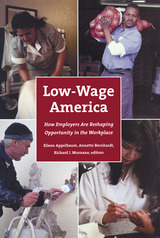2 books about Bernhardt, Annette

Divergent Paths
Economic Mobility in the New American Labor Market
Annette Bernhardt
Russell Sage Foundation, 2001
The promise of upward mobility—the notion that everyone has the chance to get ahead—is one of this country's most cherished ideals, a hallmark of the American Dream. But in today's volatile labor market, the tradition of upward mobility for all may be a thing of the past. In a competitive world of deregulated markets and demanding shareholders, many firms that once offered the opportunity for advancement to workers have remade themselves as leaner enterprises with more flexible work forces. Divergent Paths examines the prospects for upward mobility of workers in this changed economic landscape. Based on an innovative comparison of the fortunes of two generations of young, white men over the course of their careers, Divergent Paths documents the divide between the upwardly mobile and the growing numbers of workers caught in the low-wage trap. The first generation entered the labor market in the late 1960s, a time of prosperity and stability in the U.S. labor market, while the second generation started work in the early 1980s, just as the new labor market was being born amid recession, deregulation, and the weakening of organized labor. Tracking both sets of workers over time, the authors show that the new labor market is more volatile and less forgiving than the labor market of the 1960s and 1970s. Jobs are less stable, and the penalties for failing to find a steady employer are more severe for most workers. At the top of the job pyramid, the new nomads—highly credentialed, well-connected workers—regard each short-term project as a springboard to a better-paying position, while at the bottom, a growing number of retail workers, data entry clerks, and telemarketers, are consigned to a succession of low-paying, dead-end jobs. While many commentators dismiss public anxieties about job insecurity as overblown, Divergent Paths carefully documents hidden trends in today's job market which confirm many of the public's fears. Despite the celebrated job market of recent years, the authors show that the old labor market of the 1960s and 1970s propelled more workers up the earnings ladder than does today's labor market. Divergent Paths concludes with a discussion of policy strategies, such as regional partnerships linking corporate, union, government, and community resources, which may help repair the career paths that once made upward mobility a realistic ambition for all American workers.
[more]

Low-Wage America
How Employers Are Reshaping Opportunity in the Workplace
Eileen Appelbaum
Russell Sage Foundation, 2003
About 27.5 million Americans—nearly 24 percent of the labor force—earn less than $8.70 an hour, not enough to keep a family of four out of poverty, even working full-time year-round. Job ladders for these workers have been dismantled, limiting their ability to get ahead in today's labor market. Low-Wage America is the most extensive study to date of how the choices employers make in response to economic globalization, industry deregulation, and advances in information technology affect the lives of tens of millions of workers at the bottom of the wage distribution. Based on data from hundreds of establishments in twenty-five industries—including manufacturing, telecommunications, hospitality, and health care—the case studies document how firms' responses to economic restructuring often results in harsh working conditions, reduced benefits, and fewer opportunities for advancement. For instance, increased pressure for profits in newly consolidated hotel chains has led to cost-cutting strategies such as requiring maids to increase the number of rooms they clean by 50 percent. Technological changes in the organization of call centers—the ultimate "disposable workplace"—have led to monitoring of operators' work performance, and eroded job ladders. Other chapters show how the temporary staffing industry has provided paths to better work for some, but to dead end jobs for many others; how new technology has reorganized work in the back offices of banks, raising skill requirements for workers; and how increased competition from abroad has forced U.S. manufacturers to cut costs by reducing wages and speeding production. Although employers' responses to economic pressures have had a generally negative effect on frontline workers, some employers manage to resist this trend and still compete successfully. The benefits to workers of multi-employer training consortia and the continuing relevance of unions offer important clues about what public policy can do to support the job prospects of this vast, but largely overlooked segment of the American workforce. Low-Wage America challenges us to a national self-examination about the nature of low-wage work in this country and asks whether we are willing to tolerate the profound social and economic consequences entailed by these jobs. A Volume in the Russell Sage Foundation Case Studies of Job Quality in Advanced Economies
[more]
READERS
Browse our collection.
PUBLISHERS
See BiblioVault's publisher services.
STUDENT SERVICES
Files for college accessibility offices.
UChicago Accessibility Resources
home | accessibility | search | about | contact us
BiblioVault ® 2001 - 2024
The University of Chicago Press









